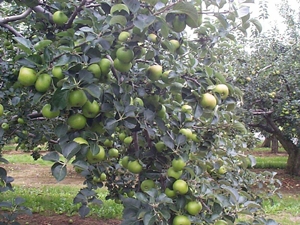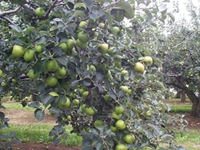
Top Fruit
Picking the best
At picking time the benefits of training your seasonal workers correctly will be seen. Good technique depends on attention to detail. Be sure to emphasise the following points to all your pickers, whether they are new to the job or not.
- Use the palm of the hand to cup and support each fruit, and avoid gripping with fingertips.
- Lift fruit off the branch rather than snatching or pulling.
- Clear the lower branches on large trees before using steps for the higher fruit.
- Remove apples singly and use each hand alternately.
- Take off the highest fruit in any cluster and work down the branch (be careful not to knock apples of the cluster).
- Do not drop the fruit or jostle the container (fruit dropping more than 2” or 50mm will bruise).
The most efficient way to pick fruit is to work around each tree in one direction. This minimises the number of ‘missed’ apples, reduces the amount of fruit that will be knocked off accidentally and is also less wasteful of time. Carefully set all apples in the picking container (bag or bucket). Fruit hitting other fruit or hitting the side of the container will lead to bruising. A useful phrase to remember is that ‘apples bruise more easily than eggs break’.
Your picking team is the main quality control system for determining the standard of apple that reaches the market. It pays to spend time training them to achieve good, consistent performance. Regular checks on the quality of fruit in the bin will help you and the pickers maintain this standard.
Ornamental crops
Vine weevil control update
The larvae of the vine weevil are a major pest of plants in containers. In the past few years two of the main pesticides used against vine weevil, Fiprinol and Chloropyrifos have been withdrawn. As a result there are reports of more vine weevil adults and larvae being found on nurseries. This is therefore an appropriate time to review your vine weevil control programme.
Vine weevil description
The larvae is cream coloured with a brown head. It is legless and is often found lying ‘C’ shaped around the roots. They feed on roots and around stem bases, normally between late summer and spring. However, under protection their life cycle can become extended due to the higher temperatures. Larvae pupate into adults which are nocturnal and feed on plant foliage. Adults are 6-8mm long, wingless and black, with pale orange flecks on their backs. They usually feed at night and cause distinctive leaf edge notching.
Control of adults
Consider foliar sprays for the control of adults and apply them in the evening.
Susceptible species
It is important to check crops regularly for evidence of the pest and damage. This should involve removing containers and examining root systems.
Current pesticides and control measures
There are a number of products available for vine weevil control by incorporation into the compost or drenching the compost.
There is also a relatively new type of product, a parasitic fungus Met 52 (Metarhizium anisopliae) impregnated on rice husks which is also incorporated in the compost for vine weevil control.
Use of nematodes
A drench or spray of parasitic nematodes can be used to control existing larvae. The nematodes will seek vine weevil larvae in moist compost, enter the larvae and release a small pellet of bacteria that kills it after a number of days. The parasitic nematode reproduces producing a number of thousands of nematodes which are able to further attack the vine weevil larvae.
If you are interested in learning more about vine weevil control and other pests and diseases of ornamental crops, a course is being held at Greenmount Campus on 23 October 2013. For more details contact David Kerr, Ornamental Crops Adviser (028 3752 9059).
INFORMATION TECHNOLOGY
Prepared by: Ronan Coll
e-mail : ronan.coll@dardni.gov.uk
telephone: 028 9442 6865
Is your data safe? – can you afford to lose the information saved on your computer?
With summer well and truly over and winter not too far away, many of you are thinking about housing livestock, laying up machinery for another year and doing a general tidy round the farm yard after what was a pretty pleasant summer. Have you ever thought about the information you have gathered during the year, data stored on your computer or information held on your smartphone? Just take a second and think what you would do if your PC or phone got damaged, lost or stolen and all the information stored on it was lost forever! If you think this is not a problem, then lucky you and you can stop reading now. However, like most of us, if your electronic data has become an essential part of your working (and social) life and the thought of losing it keeps you up at night, please read on.
Principles of an effective backup solution – keep a copy somewhere
Irrespective of the backup option you decide to use, the principle will be the same. If you have data of value, you MUST have another COPY of it saved somewhere which is not your regular computer. What you need to weigh up is the risk of losing the data and the value of the data. If the likelihood of losing the data is high, for example, information on your phone which can be easily lost or damaged and the value is high, such as details about your best customers or photos taken of your family, you must have an effective backup procedure in place.
Cheap and cheerful – sometimes the best option
The most basic form of backup can be achieved by using an external hard drive (HDD). Purchase a HDD with at least 1TB (1000GB) of storage. Such a device will cost in the region of £50, a small price to pay for peace of mind. Now it is simply a matter of copying all the valuable data from your PC to your HDD. If you have data on your phone ensure it is saved (or synced) to you PC to allow you to copy it to your HDD.
To ensure protection of your data from theft or damage, do not keep the HDD in the same place as the computer. If your PC decides to self destruct, chances are it will take your external HDD with it.
Use the software you already have to backup regularly
Any new data created since your last backup will be lost in the event of a failure. Don’t leave it too long between backups. This can become tedious and can be forgotten about. Basic applications already installed on your computer can simplify backing up procedures. They can automate the process, remind you to backup when you forget or be left to their own devices to manage the backup with no more input from you. Windows users with Vista or above have ‘Backup and Restore’ and Mac users have ‘Time Machine’. Both applications do a great job of simplifying your backups. Don’t forget, backing up your data to your HDD in your PC or leaving your external HDD attached to your PC all the time will not help if your computer is stolen or damaged.
Don’t wait until it is too late
Don’t wait until you have lost your data, it is only then that you will realise how much data you owned and how important it is to you. Use the tools already on your computer and order a new hard drive today.
Send me an email if you have any questions about this or any other IT topic you are concerned about.
HORTICULTURE
Prepared by: Kieran Lavelle
e-mail : kieran.lavelle@dardni.gov.uk
telephone: 028 3752 9060











